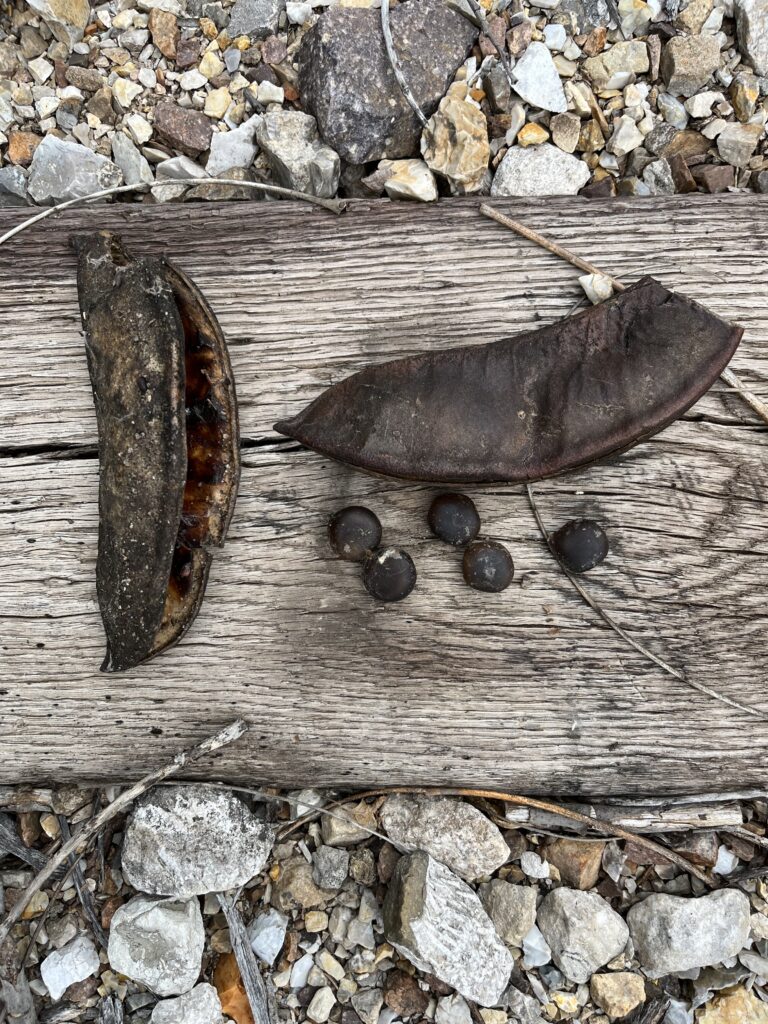When one thinks of the Great Plains, trees are often the last thing to cross one’s mind. Surprisingly this region is home to a number of species that have found their way into yards and parks throughout the United States. The honey locust, American elm, black walnut and silver maple are as common in front yards as they are along streams and patches of woodlands of the plains. One of the more beautiful native trees found in this region is the Kentucky coffeetree, a member of the legume family. Kentucky coffeetree can be found along the eastern portion of Kansas. The tree derives it name from a common practice among early Kentucky homesteaders of grinding the seeds to make a coffee-like drink.

Though somewhat uncommon in landscape plantings, the coffeetree offers many ornamental attributes. A large tree, it can reach 60 feet in height with a 30 foot spread. As of March 2022, the Kansas Forest Service state champion Kentucky coffeetree, located at Fort Leavenworth, currently stands at 100 feet tall. As the tree matures, the bark forms scaly ridges with curled edges. In winter the ascending branches present a picturesque silhouette against the winter sky. Written descriptions have labeled the tree “clumsy” looking after the leaves drop. While young trees can appear awkward their first few years, mature specimens develop stout trunks and main branches, reminding one of their innate toughness and durability.
In spring the tree may be slow to leaf out, but the patient observer is soon rewarded with bipinnately compound, bright green leaves with dainty, ovate leaflets that give the tree a soft, fine textured appearance throughout the growing season.

Kentucky coffeetrees are individual male and female trees. The botanical term for plants with male and female flowers on separate individuals is dioecious, a condition also found in Ginkgo, juniper, and Osage orange. Flowers appear in May and June as graceful racemes. The male flowers are somewhat inconspicuous and green-yellow, while the female flowers are somewhat larger and pale yellow-white. Both types of flowers are quite fragrant. Each of these flowers are favorites of pollinating insects.

Fall color is often a subdued yellow and female plants will often produce a reddish brown pod filled with incredibly hard, round, slightly flattened seeds. The hard coats allow seeds to lay dormant in the ground for long periods of time until weathering and soil bacteria wear down the tough shell, allowing germination to occur if temperature and moisture are adequate. Professional growers often soak the seed in concentrated sulfuric acid to thin the coat enough for water and gas exchange (a dangerous practice for the average home gardener). Another option is to use fine sand paper to sand down the shells so several seeds will potentially sprout. Don’t sand too much.

Due to the coffeetree’s large size and the sometimes “messy” pods from the female trees, it is often not the best selection for the average yard. However, it is well-suited to large open areas, along streams and in park settings. It is not particular about soil, but best growth occurs in deep moist ground. Drought tolerant, it experiences very few problems.
In the wild, small colonies of coffeetree can be found when new trees form from the root suckers. This is usually not a problem in the landscape if the tree is mulched and regular mowing occurs around the tree. Transplanting in most successful with small plants, because the tree develops a course fibrous root system that limits the transplanting success of larger trees.
In the Arboretum’s bird watch area, a small coffeetree is planted just below the big bridge.
I like good coffee. Lucky for us that our coffee supplies for drinking are more than adequate, but one should still consider this beautiful, tough native tree for your landscape.
